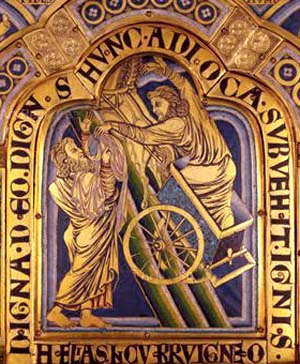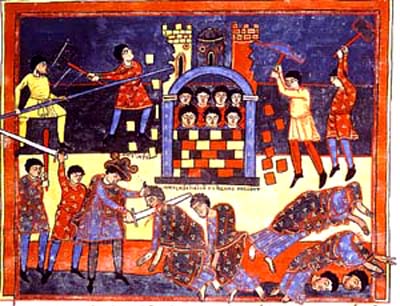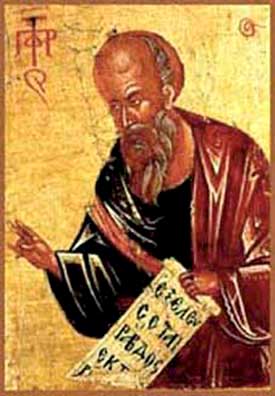 |
The Saint of the Day
St. Eliseus – June 14
Prof. Plinio Corrêa de Oliveira
The mission of St. Eliseus has a special importance for us since, as you know, St. Eliseus was the successor of St. Elias. We may consider his mission from several points of view.
First, Elias can be considered, historically speaking, the first devotee of Our Lady [click here]. Israel was passing through a terrible drought as a chastisement for its sins. Elias, who was Prophet in Israel, went to Mount Carmel to ask God to forgive the guilty people and send rain; otherwise all would die.

With the mantle of Elias, Eliseus receives his spirit
|
He remained there praying for a long time with the certainty that Divine Providence would listen to his requests. While he prayed, he sent his servant many times to look at the horizon to see if any sign of rain had appeared. The servant always retuned with the same answer: “No, there is no sign of rain.”
Elias did not give up. He continued to pray and send his servant to look and report what he saw. The seventh time, the servant came and told him: “There is a small cloud on the horizon the size of the palm of a man’s hand.” It was the sign Elias was awaiting. The small cloud began to grow and cover the sky. In a short time a long, hard rain fell that saved Israel from perishing.
This small cloud was a symbol of Our Lady, who would bear the Redeemer. With the rain of His blood, humankind would be saved from the death of Hell, destined for it as a consequence of Original Sin.
Elias, then, was the first one to pray and await the coming of Our Lady on Mount Carmel. Eliseus was the one who succeeded Elias in this devotion. After Elias, and certainly under the encouragement of Eliseus, hermits established themselves on Mount Carmel, continuing to pray for the coming of Our Lady and the Messiah. This is the origin of the Carmelite Order, which is the first Religious Order in the Catholic Church.
As the first successor and perfect disciple of Elias, Eliseus played a fundamental role in the establishment of the Carmelite Order.
Second, a very trustworthy tradition tells us that Elias made the vow of chastity, thus becoming the pioneer of the religious life from this perspective as well. In the Old Covenant this vow was rare, since to be in the ancestral line of the Messiah was justly considered the greatest honor a Jew could have. Therefore, no one considered making this vow.
However, in this sphere Elias also had a prophetic understanding. He realized what St. Thomas would express perfectly centuries later: By means of marriage mankind continues to grow; by means of chastity mankind continues to see the great panoramas and discern the direction it should take. The first state of life, St. Thomas taught, is symbolized by man’s feet, which allow him to walk; the second state, that of chastity, is symbolized by his eyes, which allow him to see. Elias understood this. Since he was called to comprehend, judge, and fight for the greatest causes of God during his life and at the end time, he sensed the need to be chaste. So he took the vow of chastity.

The Antichrist will slay Elias and Enoch
|
Here also, Eliseus maintained the vow of chastity, which would become one of the most sublime marks of the religious life.
Third, as the founder of devotion to Our Lady, Elias most probably had that special form of devotion taught by St. Louis Grignion de Monfort, who was himself the founder of the Apostles of the Last Times. This true devotion to the Virgin Mary consists of the complete deliverance of one’s will to her will so that she can do with him whatever she pleases. This is what St. Louis de Monfort called Sacred Slavery. I think that Elias and Eliseus and those who followed them would have known this devotion, at least in its germination stage.
Elias, as the Church teaches, must return in the Last Times. He must return not only in the Last Times, generically speaking, but in the last days of History to fight against the Antichrist. He will be the greatest and most expressive Apostle of the Last Times.
It is interesting to consider the mystical relation of these two great Saints and Prophets with Our Lady and also their relation to each other. Elias was her first devotee; St. Grignion de Monfort brought her devotion to an apex. St. Louis foresaw the Apostles of the Last Times, and the culmination of the Apostles of the Last Times will be Elias. Both are mysteriously linked to her and to one another.
The fight Elias had during his mission in Israel, and principally the fight against the Antichrist that he will direct at his second coming make him the precursor of the Counter-Revolution and the one who will conduct it to its most important battle. Everything that we do today fighting the Revolution in the temporal and religious sphere are related in one way or another to that apex which will be the confrontation of Elias and the Antichrist.

St. Eliseus
|
Now then, Eliseus asked and received the spirit of Elias when he left this earth in a chariot of fire. In this request there was a mystical and beautiful reality that is the transmission of the spirit. How is the spirit of a man transmitted? How can a grace that is characteristic of one man pass to another, making the latter the alter ego of the former?
Here is not the place to delve into this mystical concept. But one can say that the spirit of a founder of an institution can be transmitted to his successors just as Elias transmitted his spirit to Eliseus. In the Church we can speak about the spirit of the Carmelites, Benedictines, Dominicans, Franciscans, Jesuits, etc. Each one of these religious institutions has its own spirit that is the spirit of its founder, which was passed to his disciples.
Eliseus received the spirit of Elias and, therefore, he received his counter-revolutionary spirit in order to direct the fight against the enemies of God in his time. He is, then, a special protector of the fight against Progressivism in the Church, which has infiltrated the highest positions of the Church in order to destroy her. Progressivism is today the very point of the lance of the Revolution.
So, Eliseus is our patron Saint in several ways: as the devotee of Our Lady at Mount Carmel, as the one who practiced chastity, and as the one who continued the fight of the Counter-Revolution. Under each of these titles we should ask him to give us his spirit, which is the spirit of Elias.


  | | Prof. Plinio Corrêa de Oliveira | |
The Saint of the Day features highlights from the lives of saints based on comments made by the late Prof. Plinio Corrêa de Oliveira. Following the example of St. John Bosco who used to make similar talks for the boys of his College, each evening it was Prof. Plinio’s custom to make a short commentary on the lives of the next day’s saint in a meeting for youth in order to encourage them in the practice of virtue and love for the Catholic Church. TIA thought that its readers could profit from these valuable commentaries.
The texts of both the biographical data and the comments come from personal notes taken by Atila S. Guimarães from 1964 to 1995. Given the fact that the source is a personal notebook, it is possible that at times the biographic notes transcribed here will not rigorously follow the original text read by Prof. Plinio. The commentaries have also been adapted and translated for TIA’s site.
|
Saint of the Day | Home | Books | CDs | Search | Contact Us | Donate

© 2002- Tradition in Action, Inc. All Rights Reserved
|
 |

|